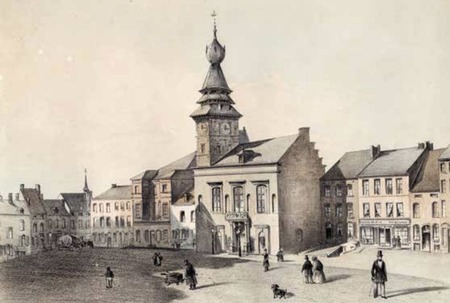
History and heritage
With its stone walls spanning 2 kilometers and 25 towers, Binche, a small Medieval city, constitutes a unique collection of monuments awaiting your discovery in Belgium.
Its ancient nature explains its originality, traditional spirit, as well as the ritual character of certain customs little known to the public at large. Binche recounts to us its rich history of lace making and crafts, brasseries, the building of great monuments in the region’s architectural and religious heritage. Binche is a mosaic of vibrant colors, lively and welcoming, which only asks to be embraced...
The name of Binche – Bincium - appears for the first time in 1124 in a charter of Bruchard, Bishop of Cambrai. This document sadly only serves to prove the existence of a chapel attached to the mother parish of Waudrez.
According to various writers, Binche was born from a dungeon built towards the end of the 11th century or the beginning of the 12th century, by the Counts of Hainaut, on a slight, rocky promontory, surrounded by the Samme river. The existence of this dungeon would also have convinced the Countess, Yolande of Guelders, wife of Baldwin III, to carve out tens of hectares from the Waudrez freehold and award this territory privileged status. A new town was born.
Tradesmen and craftsmen settled in ever greater numbers within this new town, encouraging its rapid economic development. Baldwin IV then decided to surround the settlement with a walled enclosure. These fortifications were closed off to the North by the present roads of “Trois Escabelles” and “Gaieté”. Binche from then on played a military role; the Counts installed a garrison there and notably, a Castellan.
From the end of the 12th century, this embryonic stage of the town’s development had finished.
Following the continued growth in the population, too many households found themselves cast outside the walls and pasture land within the walls became too scanty to survive any siege. Part of the seignory of Battignies was purchased and annexed to the town to allow expansion of the primitive enclosure, whose land area encompassed a territory of 22 hectares.
The face of the town was thus set until the mid-19th century. The people of Binche lived for centuries in this cramped space, leading to over-population, which only carried on growing in line with the City’s development.
It was only as a result of the construction of the railroad in the Centre and the building of the station in 1857 that a major district came to be born outside the walls. Improvements to public utilities linking it to neighboring towns then brought about profound change: the substantial growth in the number of buildings and new industries led to it rapidly losing its rural aspect.
With this change, the town took an industrial turn and plentiful, new infrastructure saw the light of day (cloth manufacture, malt-houses, etc.)
Its compound cracked, walls were torn down, one after the other, and the ancient gates, which hindered traffic, the covered way was built upon, over the filled-in ditches, or up against the ramparts. During the second half of the 19th century, new territory was taken over: the hamlets of Battignies and Versailles (station quarter).
The town, during this period, presented itself in two distinct aspects: new quarters with well-maintained facades and slums in front of dead ends and alleyways, located for the most part above the ramparts.
Numerous facades still bear witness to this burgeoning, with “Art Nouveau” facades across the town and those of an eclectic architecture, which all form part of Binche’s riches.
From the end of the 19th century, the local authorities’ awareness of the situation triggered a housing policy, which has been followed into our times: closure and demolition of the slums and substandard housing, removal of the ramparts and the construction of social housing.
The beginning of the 20th century was above all characterized by the rapid expansion of quarters outside the walls, the “faubourgs” of “Saint-Jacques”, “Posty” and “Phénix”, the station quarter and the “Avenue Marie-José”. The space within the walls had been almost entirely built upon, to the detriment of courtyards and gardens.
The inter-war years saw the birth of new quarters, such as the “Place du Centenaire” and the “Rue E. Drisse” and “Rue Prince Baudouin”. The “Avenue J. Hachette” was bordered by housing. Two major quarters were created after 1950, the Garden City and the “Athénée” quarter.
In 1977, following the merger of Belgian townships, seven neighboring areas - Bray, Buvrinnes, Epinois, Leval-Trahegnies, Péronnes, Ressaix and Waudrez - were incorporated into the town to give it its present form.
With the merger of these townships, Binche inherited an industrial, mining heritage, yet also a flourishing and verdant countryside.



Document Actions